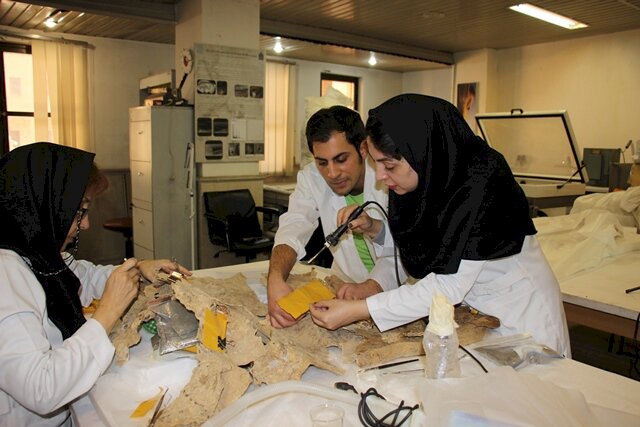Salt mummies’ leather belongings restored, reorganized

TEHRAN –Remains of leather belongings of the ancient salt men, found in Iran’s Chehrabad Salt Mine in Zanjan province, have recently been restored and reorganized.
The project, which was carried out by Iran's Research Center for Conservation of Cultural Relics, aimed to protect and preserve the properties, considered the oldest leather objects ever discovered in the country, the head of the project has announced.
In this project, it was important to identify and transform objects that were used mainly for research and study into museum objects, CHTN quoted Narges Afzalipur as saying on Monday.
Project also includes documentation and traumatology, preparing an identity card, conducting wet and dry chemical tests, using a digital microscope, mechanical cleaning, labeling, softening, and dehumidification of parts, assembly and gluing of parts, reinforcement, packaging and photography, she added.
Back in January, the center implemented a project for documenting and reorganizing ancient salt men and their belongings in Zolfaghari Museum in the northwestern city of Zanjan.
The collections of salt men and their belongings were purified, cleansed, and restored during the project, which was carried out in collaboration with the Archaeological Museum Frankfurt, the Ruhr-Universität Bochum, and Zanjan’s Cultural Heritage, Tourism and Handicrafts Department.
The project also aimed at desalinating, strengthening, and reconstructing the salt men and their properties as well as preventing further damage to them.
In 1993, miners in the Douzlakh Salt Mine, near Hamzehli and Chehrabad villages in Zanjan Province, accidentally came across a mummified head, dated to 300 CE. The head was very well preserved, to the extent that his pierced ear was still holding the gold earring. The hair, beard, and mustaches were reddish, and his impressive leather boot still contained parts of his leg and foot, according to the Ancient History Encyclopedia.
However, in 2004, the miners discovered yet another “saltman,” which was followed by further excavation and unearthing remains of a human body along with a large number of artifacts made of wood, metal tools, clothing, and pottery.
In 2005, a systematic excavation began, three more mummies were excavated, and a sixth remained in situ due to lack of funds for its storage. The context of the remains suggested that a collapse in the mine had caused the death of the miners in question.
The first mummy dubbed the “saltman,” is on display in the National Museum of Iran in Tehran. He still looks very impressive.
This particular “saltman” was originally dated based on the archaeological material found with him. Later, the mummy was carbon dated, which placed him in 500 CE (1750 BP, that is, “before present” or 1750 years ago), the Sasanian Empire's height. The second “Saltman” was carbon-dated to 1554 BP, which placed him in the same era as the first “saltman,” the Sasanian era.
The third, fourth, and fifth “saltmen” were also carbon dated. The third body was dated and placed in 2337 BP, the fourth body in 2301 BP, and the fifth mummy was dated to 2286 BP, placing them all in the Achaemenid period.
The individual “saltmen” has a few secrets of their own, for instance, the first “saltman” that was discovered had the blood type B+, and 3D imaging of his skull revealed fractures around his eye and other damage that occurred before death by a hard blow to the head. His clothing (the impressive leather boot) and his gold earring show a person of some rank; the reason for his presence in the mine still remains a mystery.
Saltman No. 5 had tapeworm eggs from the Taenia sp. genus in his system. These were identified during the study of his remains. The find indicates the consumption of raw or undercooked meat, and this is the first case of this parasite in ancient Iran and the earliest evidence of ancient intestinal parasites in the area. The best preserved and probably the most harrowing of the bodies is “saltman” No. 4. A sixteen-year-old miner, caught in the moment of death, crushed by a cave-in.
ABU/MG
Leave a Comment